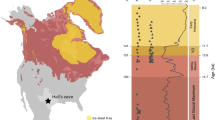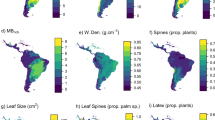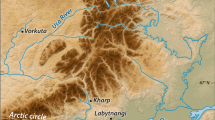Abstract
Field study of the fossil and sedimentary record across the Cretaceous–Tertiary (K–T) boundary in Wyoming and Montana has been combined here with a reassessment of the published record of terrestrial palynomorphs to test recent hypotheses that a universal biotic catastrophe caused by an asteroid1–3, cometary impact4 or a supernova5 terminated the Cretaceous. Evidence from land plants is particularly critical because plants form the base of the terrestrial food chain. Thus, massive disruptions of the Earth's vegetation by the postulated effects of a cosmic disaster (blocking of solar radiation for several years by a dust cloud1, severe atmospheric heating1,4,6,7 or ionizing radiation5) would have an amplified effect on the land fauna. However, I report here that the geographically uneven and generally moderate levels of extinction and diversity change in the land flora, together with the non-synchroneity of plant and dinosaur extinctions, contradict hypotheses that a catastrophe caused terrestrial extinctions.
This is a preview of subscription content, access via your institution
Access options
Subscribe to this journal
Receive 51 print issues and online access
$199.00 per year
only $3.90 per issue
Buy this article
- Purchase on Springer Link
- Instant access to full article PDF
Prices may be subject to local taxes which are calculated during checkout
Similar content being viewed by others
References
Alvarez, L. W. et al. Science 208, 1095–1108 (1980).
Smit, J. & Hertogen, J. Nature 285, 198–200 (1980).
Gagnapathy, R. Science 209, 921–923 (1980).
Hsü, K. J. Nature 285, 201–203 (1980).
Russell, D. & Tucker, W. H. Nature 229, 553–554 (1971).
Hughes, N. F. Palaeobiology of Angiosperm Origins (Cambridge University Press, 1976).
McLean, D. M. Science 201, 401–406 (1978).
Pacltová, B. Preslia 33, 113–129 (1961).
Wolfe, J. A. Am J. Bot. 59, 664 (1972).
Hickey, L. J. Am. J. Bot. 60, 17–33 (1973).
Dilcher, D. L. Bot. Rev. 40, 1–1547 (1974).
Hickey, L. J. in Catastrophes in Earth History: The New Uniformitarianism (eds Berggren, W. A. & Van Couvering, J. A.) (Princeton University Press, in the press).
Doyle, J. A. & Hickey, L. J. in Origin and Early Evolution of Angiosperms (ed. Beck, C. B.) 139–206 (Columbia University Press, New York, 1976).
Hickey, L. J. & Doyle, J. A. Bot. Rev. 43, 3–104 (1977).
Hughes, N. F. Bot. Rev. 43, 3–104, 105–127 (1977).
Vakhrameev, V. A. & Kotova, I. Z. Paleont. Zh. 1977, 101–109 (1977).
Doyle, J. A. et al. Bull. Ant. Rech. Explor.-Prod. Elf-Aquitaine 1, 451–473 (1977).
Penny, J. S. in Aspects of Palynology (eds Tschudy, R. H. & Scott, R, A.) 331–376 (Wiley-Interscience, New York, 1969).
Doyle, J. A. J. Arnold Arbor. 50, 1–35 (1969).
Muller, J. Biol. Rev. 45, 417–450 (1970).
Mchedlishvili, N. D. Trudy VNIGRI 177, 1–342 (1961).
Stanley, E. A. Bull. Ga Acad. Sci. 28, 1–44 (1970).
Krassilov, V. A. Palaeontographica B 142, 105–116 (1973).
Pacltová, B. Cour. Forsch.-Inst. Senckenberg 30, 70–76 (1978).
Niklas, K. J., Tiffney, B. H. & Knoll, A. H. in Evolutionary Biology (eds Hecht, M. K., Steere, W. C. & Wallace, B.) 1–89 (Plenum, New York, 1980).
Bailey, I. W. & Sinnott, E. W. Science 41, 832–833 (1915).
Wolfe, J. A. Prof. Pap. U. S. geol. Surv. 1106, 34–35 (1979).
Hickey, L. J. Mem. geol. Soc. Am. 150, 57–71 (1977).
Bebout, J. W. thesis, Pennsylvania State Univ. (1977).
Lerbekmo, J. F., Evans, M. E. & Baadsgaard, H. Nature 279, 26–30 (1979).
Clemens, W. & Archibald, D. Mém. Soc. géol. Fr. 139, 67–74 (1980).
Leffingwell, H. A. Spec. Pap. geol. Soc. Am. 127, 1–64 (1970).
Newman, K. B. in Cretaceous–Tertiary Boundary Events II (eds Christensen, W. K. & Birkelund, T.) 246–248 (University of Copenhagen, 1979).
Van Valen, L. & Sloan, R. E. Evol. Theory 2, 37–64 (1977).
Gartner, S. in Cretaceous–Tertiary Boundary Events II (eds Christensen, W. K. & Birkelund, T.) 26–28 (University of Copenhagen, 1979).
Saito, T. & Van Donk, J. Micropaleontology 20, 152–177 (1974).
Savin, S. M. A. Rev. Earth planet. Sci. 5, 319–355 (1977).
Raunkiaer, C. The Life Forms of Plants and Statistical Plant Geography: Being the Collected Papers of C. Raunkiaer (Clarendon Press, Oxford, 1934).
Cain, S. A. Bot. Rev. 16, 1–32 (1950).
Woodwell, G. M. Scient. Am. 208 (6), 40–49 (1963).
Samilovich, S. R. Rev. Palaeobot. Palynol. 2, 127–139 (1967).
Smiley, C. J. Geosci. Man 4, 91–99 (1972).
Srivastava, S. K. Palaeogeogr. Palaeoclimatol. Palaeoecol. 7, 221–276 (1970).
Krassilov, V. A. Palaeogeogr. Palaeoclimatol. Palaeoecol. 17, 152–172 (1975).
Boersma, A. et al. Init. Rep. DSDP 43, 695–719 (1979).
Boersma, A. & Shackleton, N. in Cretaceous–Tertiary Boundary Events II (eds Christensen, W. K. & Birkelund, T.) 50–53 (University of Copenhagen, 1979).
Jarzen, D. M. Pollen Spores 20, 535–553 (1978).
Smith, A. G. & Briden, J. C. Mesozoic and Cenozoic Paleocontinental Maps (Cambridge University Press, 1977).
Stover, L. E. & Partridge, A. O. Proc. R. Soc. Vict. 85, 237–286 (1973).
Stover, L. E. & Evans, P. R. Spec. Publs geol. Soc. Aust. 4, 55–72 (1973).
Couper, R. A. Palaeont. Bull., Wellington 32, 1–84 (1960).
Leidelmeyer, P. Leid. geol. Meded. 38, 49–70 (1966).
Muller, J. Micropaleontology 14, 1–37 (1968).
van Hocken-Klinkenberg, P. M. J. Leid. geol. Meded. 38, 37–48 (1966).
Müller, H. in Proc. of the Second West African Micropaleontological Colloquium, Ibaden, No 5 (ed. van Hinte, J. E.) 123–136 (Brill, Leiden, (1966).
Germeraad, J. H., Hopping, C. A. & Muller, J. Rev. Palaeobot. Palynol. 6, 189–348 (1968).
Kedeves, M. Acta bot. sci. Hung. 17, 371–378 (1971).
de Boer, N. P., van der Hammen, T. & Wymstra, T. A. Geologie Mijnb. 44, 254–258 (1965).
Krutsch, W. Z. Angew. Geol. 3, 509–548 (1957).
Zaklinskaya, E. D. in Razvitie Flor na Granitse Mezozoya i Kainozoya (ed. Vakhrameev, V. A.) 66–119 (Nauka, Moscow, 1977).
Tschudy, R. H. Prof. Pap. U.S. geol. Surv. 865, 1–42 (1975).
Zaklinskaya, E. D. in Paleozoiskie i Mezozoiske Flori Evrazii i Fitogeografiya etogo Vremeni. (eds Vakhrameev, V. A. et al.) 302–331 (Nauka, Moscow, 1970).
Tschudy, R. H. Spec. Pap. geol. Soc. Am. 127, 65–111 (1970).
Drugg, W. S. Palaeontographica B120, 1–71 (1967).
Shoemaker, R. E. Palaeontographica B119, 54–75 (1966).
Mamontova, I. V. in Paleobotanika na Dal'nem Vostoke (ed. Krassilov, V. A) 32–37 (Institute of Biology and Pedology, Vladivostok, 1977).
Dorf, E. Bull. geol. Soc. Am. 51, 213–236 (1940); Publs Carnegie Instn 508, 79–159 (1942).
Dorf, E. Publs Carnegie Instn 508, 1–78 (1938).
Vakhrameev, V. A. & Achmetev, M. A. in Razvitie Flor na granitse Mezozoya i Kainozoya (ed. Vakhrameev, V. A.) 39–65 (Nauka, Moscow, 1977).
Stanley, E. A. Bull. Am. Paleont. 49, 179–383 (1965).
Norton, N. J. & Hall, J. W. Palaeontographica B125, 1–92 (1969).
Hickey, L. J. Contr. Mus. Paleont. Univ. Mich. 24, 33–49 (1980).
Author information
Authors and Affiliations
Rights and permissions
About this article
Cite this article
Hickey, L. Land plant evidence compatible with gradual, not catastrophic, change at the end of the Cretaceous. Nature 292, 529–531 (1981). https://doi.org/10.1038/292529a0
Received:
Accepted:
Issue Date:
DOI: https://doi.org/10.1038/292529a0
This article is cited by
-
Palaeobotanical evidence for a marked temperature increase following the Cretaceous/Tertiary boundary
Nature (1990)
-
High-resolution leaf-fossil record spanning the Cretaceous/Tertiary boundary
Nature (1989)
-
Late Cretaceous and paroxysmal Cretaceous/Tertiary extinctions
Nature (1987)
-
Vegetation, climatic and floral changes at the Cretaceous-Tertiary boundary
Nature (1986)
-
Mass extinctions: Catastrophic vegetation changes
Nature (1986)
Comments
By submitting a comment you agree to abide by our Terms and Community Guidelines. If you find something abusive or that does not comply with our terms or guidelines please flag it as inappropriate.



